Adgang til tjenester er ofte værst i forstæder
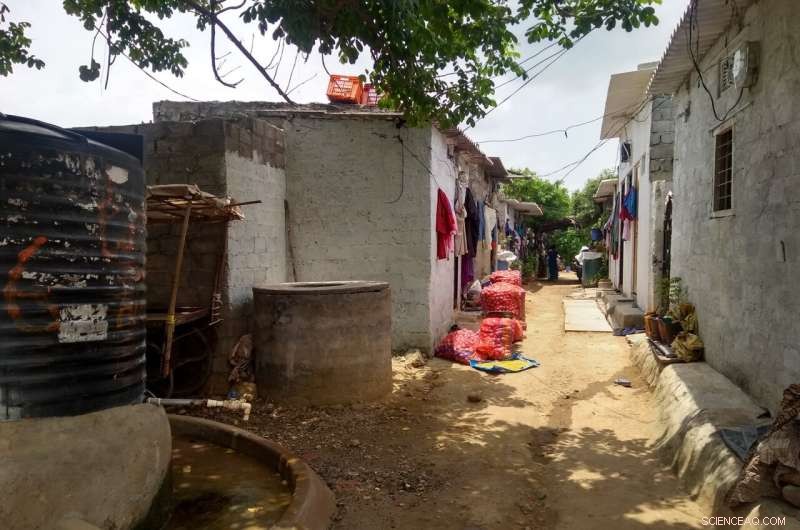
Dette billede er taget i et peri-urbant område nær Hyderabad, Indien. I forgrunden kan du se den tilgængelige infrastruktur til at levere vand. Området er endnu ikke tilsluttet det ledningsførte vandsystem, men disse store vand men kan fyldes via regnvand, eller med vand leveret til området med lastbiler. I mellemgrunden ses store poser med mad, som kan transporteres ind i området ved hjælp af køretøjer, husdyr og med håndkraft. I baggrunden er det resterende grønne område til stede - en skarp kontrast til de relativt tætte boliger i mellemgrunden. Kredit:Professor Simon Willcock
Den verden, vi lever i, er ofte opdelt ved hjælp af en binær skelnen mellem by og land, på trods af en enorm gradient af bosættelsesmønstre i og omkring byer – lige fra byer til de mest fjerntliggende landdistrikter. Ny forskning ledet gennem et fælles U.K.-Indien forskningsprojekt og offentliggjort i Nature Sustainability , overvejer urbanisering ved at se på skift i naturlig, konstrueret og institutionel infrastruktur. Undersøgelsen, der fokuserer på det globale syd, tyder på, at hurtige ændringer i forstæder (kaldet "peri-urbane") områder resulterer i, at mennesker, der bor i disse områder, har en dårligere livskvalitet end folk, der bor i by- og landområder.
"Verdens bybefolkning vil fortsætte med at vokse, hvilket fører til en stadig mere urbaniseret planet, hvilket ofte resulterer i byudvidelse, efterhånden som byer strækker sig udad og inkorporerer jord omkring dem. Denne udvidelse af byer er især hurtig i udviklingslande i Asien og Afrika," siger professor Kenneth Lynch (University of Gloucestershire).
Professor Simon Willcock fra Bangor University og Rothamsted Research siger:"I takt med at byområder udvides, ændres de karakteristika og tjenester, der er tilgængelige inden for områder. For eksempel er natur og naturprodukter ofte mere umiddelbart tilgængelige i landdistrikter, med lavere niveauer i byområder, mens bygget infrastruktur viser det modsatte mønster. Dette er nogle gange også ledsaget af et skift fra lokalt, traditionelt lederskab i landdistrikter til mere central styring i byer."
Forskningen præsenterer en ny teori om Peri-Urban Turbulens, som Dr. Paul Hutchings fra Leeds University forklarer:"Naturens hastighed er beskadiget, og omkostningerne ved at bygge ny infrastruktur er vigtige faktorer for at bestemme livskvaliteten for mennesker, der bor i peri. For eksempel, når udvinding af produkter fra naturen har en høj miljøomkostning, så kan naturen kun understøtte et lille antal mennesker. Tilsvarende, når omkostningerne ved at bygge infrastruktur også er høje, så er det kun økonomisk rentabelt at understøtte større samfund. I en situation som denne vil ressourcer, der kommer fra den naturlige verden, sandsynligvis forsvinde, før de kan erstattes af bygget infrastruktur."
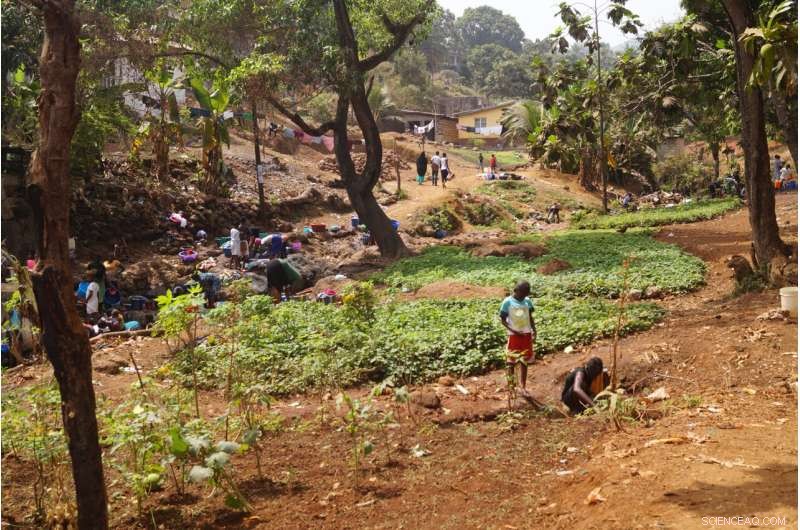
Dette billede er taget mellem to kvarterer, der kigger op ad et vandløb nær Freetown, Sierra Leone. I forgrunden kan du se to børn udvinde vand fra en brønd for at vande små køkkenhaver bag dem. In the middle ground, a group of women and children are washing clothes and themselves in the stream and up the slope and behind the banana trees, the residential dwellings, some of which are in construction. You can also observe, rubbish littering the catchment, building materials in the form of boulders, some of which have been arranged to reduce erosion and landslip and dotted about some mature trees, some of which show evidence of having branches removed for fuelwood. Credit:Professor Kenneth Lynch
"Previous evidence supports this. For example, child health in East Africa is lowest in those communities living between the city and countryside, whilst a study in South Africa found that around two thirds of urban and rural citizens report that their quality of life had improved over the last five years, but only half of respondents reported such improvement in peri-urban zones," says Professor Kenneth Lynch.
Professor Simon Willcock explains the limitations of the theory:"This type of negative experience in peri-urban areas is greater for some services than others, and varies across geographic areas. For example, most food is grown in rural areas, but this can also be done within cities. Food can also be transported by road within cities with relative ease. However, there are likely to be big differences between groups living in each context. For example, higher income households and communities living in peri-urban areas have better access to the scarce resources. They can buy-in their own water, electricity, sanitation and so forth."
-
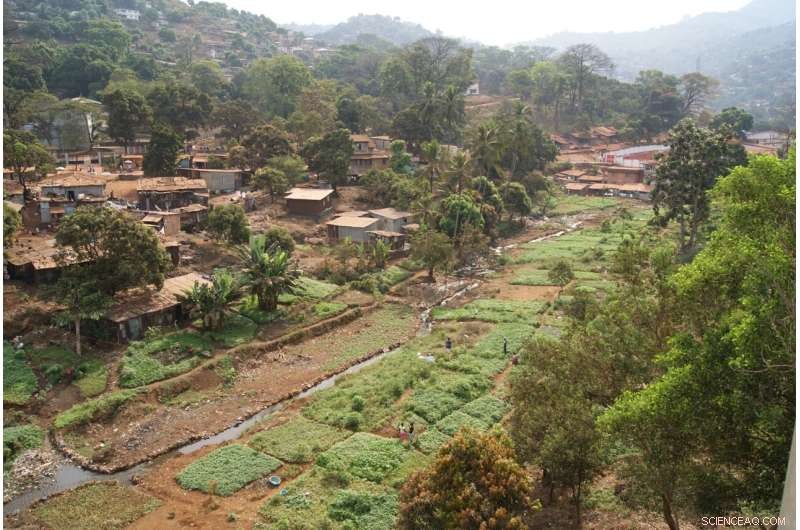
A site that floods during the rainy season that has thus far prevented development, allowing local people to use it for small-scale vegetable gardens near Freetown, Sierra Leone. Since this photo was taken two large developments have encroached on this site displacing the cultivators reducing the cultivated land cover and restricting the drainage channel, exacerbating flood water during the rainy season. Non-biodegradable waste (such as plastic bags and bottles) is used by cultivators to form drainage channels and protect plots from erosion. Credit:Professor Kenneth Lynch
-
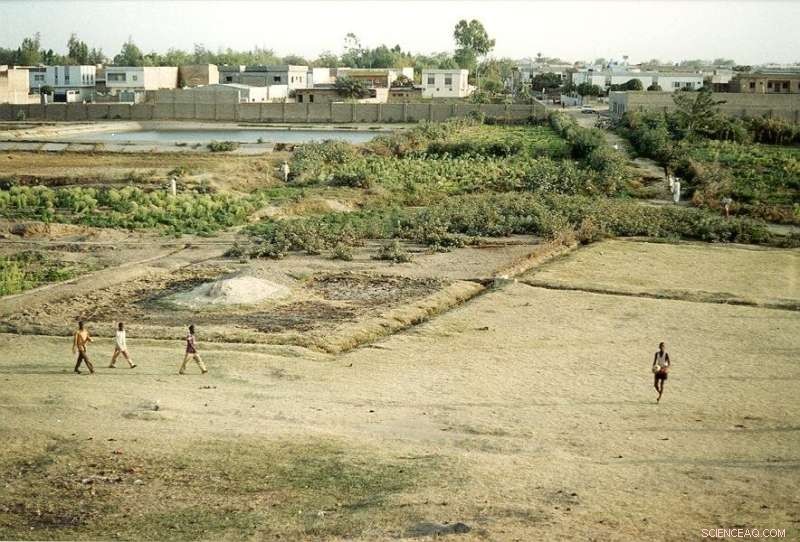
A seasonally flooded site within the old walls of the city of Kano, Northern Nigeria. You can see sites in the foreground are being used for small scale agriculture, but also plots have been marked out for construction and some sand and cement has been deposited ready for the installation of boundary markers. In the background you can see the high value residential areas that have a wall separating their neighborhood from the agricultural site. Many of the cultivators grow rice in the rainy seasons indicating this is for household consumption. During the dry season the cultivable land reduces to very close to the stream which is heavily polluted by nearby clothes dying works and the residential area. Encroachment on this site for residential development will exacerbate flooding further down the watershed. Credit:Professor Kenneth Lynch
-
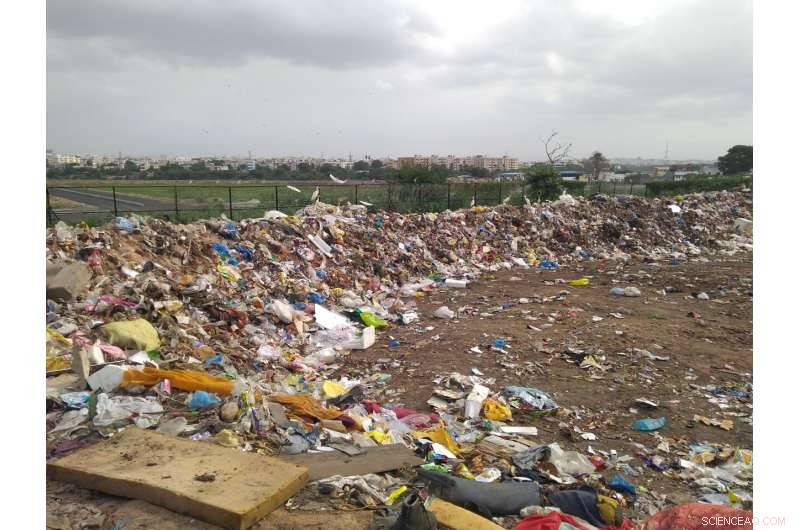
This photo is taken in a peri-urban area near Hyderabad, India. In the foreground, you can see a waste disposal area, receiving waste from the surrounding peri-urban areas, but also from the main city (shown in the background). This waste may present a hazard to the health of those living nearby, and risks polluting the nearby natural areas (shown in the middle ground). Credit:Professor Simon Willcock
Dr. Paul Hutchings concludes, "The bumpy road between natural and built infrastructure can be avoided. Some natural infrastructure can be conserved throughout urbanization through good city planning enforcing protection of green space. As well as this, services, such as municipal water utilities, can be subsidized so that they can be provided to people in peri-urban areas. Urban and rural planners, designers and architects should be working together to pre-empt the needs within newly expanded areas, and act quickly to prevent lower quality of life of the people living there." + Udforsk yderligere
Study maps urban-rural catchment areas and points to ways to optimize policy and planning coordination for agriculture
Sidste artikelVores børn er ikke længere fritgående
Næste artikelNy forskning afslører skammelig omfang af børnefattigdom i New Zealand
 Varme artikler
Varme artikler
-
 Gammel migration var valg, ikke tilfældighed, undersøgelse finderEt kandidatbambusfartøj til Ryukyu-migrationen bygget til en genopførelse af den krydsning. Kredit:© 2020 Yosuke Kaifu Graden af intentionalitet bag gamle havvandringer, som det til Ryukyu-øerne
Gammel migration var valg, ikke tilfældighed, undersøgelse finderEt kandidatbambusfartøj til Ryukyu-migrationen bygget til en genopførelse af den krydsning. Kredit:© 2020 Yosuke Kaifu Graden af intentionalitet bag gamle havvandringer, som det til Ryukyu-øerne -
 Sådan undervises grundlæggende matematik til en 7-årigEfter 7-årsalderen kan mange børn beregne antallet af operationer, der resulterer i svar til teenagere, ifølge PBS Forældres websted. Ikke kun kan førsteklassinger tilføje og trække, de kan også bruge
Sådan undervises grundlæggende matematik til en 7-årigEfter 7-årsalderen kan mange børn beregne antallet af operationer, der resulterer i svar til teenagere, ifølge PBS Forældres websted. Ikke kun kan førsteklassinger tilføje og trække, de kan også bruge -
 Forskning citerer fejlagtig videnskab og etik i DNA-analyser af AtaLektor Sian Halcrow fra University of Otago, New Zealand, og hendes kolleger fra universiteter i USA, Sverige og Chile, har fremhævet en række bekymringer omkring forskning i Atacama-mumien, udført af
Forskning citerer fejlagtig videnskab og etik i DNA-analyser af AtaLektor Sian Halcrow fra University of Otago, New Zealand, og hendes kolleger fra universiteter i USA, Sverige og Chile, har fremhævet en række bekymringer omkring forskning i Atacama-mumien, udført af -
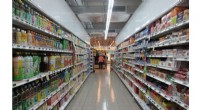 Hvorfor big-box kæder omfavner klik-og indsamle blade penge på bordet i butikkenKredit:Pixabay/CC0 Public Domain Forskere fra University of North Carolina-Chapel Hill og Tilburg University offentliggjorde et nyt papir i Journal of Marketing der udforsker fremkomsten af kl
Hvorfor big-box kæder omfavner klik-og indsamle blade penge på bordet i butikkenKredit:Pixabay/CC0 Public Domain Forskere fra University of North Carolina-Chapel Hill og Tilburg University offentliggjorde et nyt papir i Journal of Marketing der udforsker fremkomsten af kl
- Sådan konverteres punkthældningsform til hældningsaflytningsformular
- Bestemmelse af, hvad der binder til slim
- Tidligere brande kan være nøglen til at reducere alvorligheden af fremtidige naturbrande i det v…
- Frankrig stiller krav til nanopartikler
- Astronauter kan snart bryde (og bage) brød i rummet
- Video:European Robotic Arm klar til rummet


